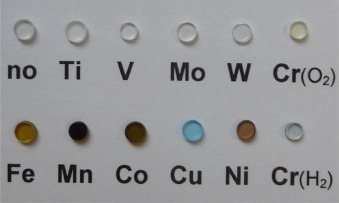Ask for a reprint
email :
* Give your email
2023
ACL
|
A.Zandonà, V.Castaing, A.I.Shames, G.Helsch, J.Deubener, A.Isabel Becerro, M.Allix, A.Goldstein, 'Oxidation and coordination states assumed by transition metal dopants in an invert ultrabasic silicate glass', J. Non-Cryst. Solids 603 122094 (2023) doi:10.1016/j.jnoncrysol.2022.122094
An ultrabasic invert silicate glass (46SiO2·11Na2O·21CaO·22BaO, optical basicity index equal to 0.71) was synthesized (O2 atmosphere) and used as host for various transition metal dopants. Optical absorption, emission and electron paramagnetic spectroscopies were used to characterize oxidation and coordination states. Some of the dopants displayed only their maximal oxidation state (Ti4+, V5+, Cr6+, Mo6+ and W6+). Others exhibited mixed valences: (i) Mn3+ was the dominant species, alongside Mn2+ and Mn5+; (ii) stable Fe3+ prevailed, although some Fe2+ was preliminarily suggested by the absorption spectrum; (iii) Co3+ probably accompanied the dominant Co2+ tetrahedral oxide complex; (iv) like in “conventional” silicate glasses, only Ni2+ was detected, though simultaneously located in tetrahedral and octahedral sites (somewhat distorted); (v) Cu+ was surprisingly identified alongside the expected 6-fold coordinated Cu2+. Drastic reduction of the oxygen content in the melting atmosphere led to conversion of Cr6+ to Cr3+, despite the extreme basicity of the host.
|

|